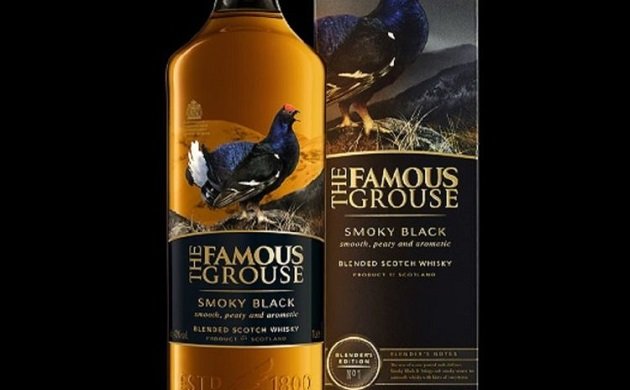
Whisky Month at Birds and Booze:
This January, Birds and Booze at 10,000 Birds is setting its sights on whiskies all month long. The cold and dreary dead of winter is as good a reason as any to warm up with a restorative dram of uisce, especially after a blustery morning spent scanning flocks of gulls on an icy shore, trudging through woodland snowdrifts in search of new year-birds, or any other half-crazed birding one does in January. But seeing as the month is also bookended by Hogmanay and Burns Night, we’ll gladly take the opportunity to visit– in spirits, at least – the rugged Celtic landscapes of Scotland and Ireland where whisky was born and – with luck – have a look at the birds that inhabit them.
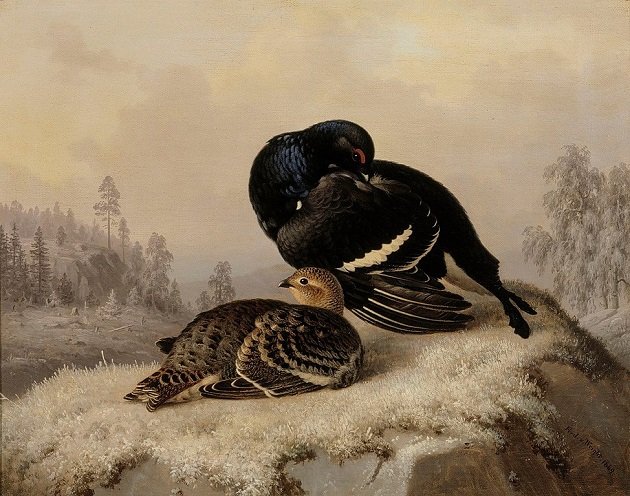
Black Grouse, Cock and Hen (1869) by Finnish painter Ferdinand von Wright (1822-1906).
Admiring Nature in her wildest grace,
These northern scenes with weary feet I trace;
O’er many a winding dale and painful steep,
Th’ abodes of covey’d grouse and timid sheep…
An excerpt from the 1787 poem “Written with a Pencil Over the Chimney-piece in the Parlour of the Inn at Kenmore, Taymouth” by Robert Burns (1759-1796)
Obviously, the Scottish poet Robert Burns knew the birds of his native land well enough to understand that while he might get away with calling sheep “timid”, the tough grouse of the Highlands are anything but meek and won’t stand for such slander. All four species of the grouse family found in Scotland – the Willow Ptarmigan (Lagopus lagopus), the Rock Ptarmigan (Lagopus muta), the Black Grouse (Tetrao tetrix), and the Western Capercaillie (Tetrao urogallus) – are notorious for the ritualized hostility of their courtship displays, which feature plenty of dramatic puffing, pugnacious posturing and strutting, and squaring up against all challengers. This boldness isn’t restricted to exchanges with other grouse, either: in some locales, members of this circumpolar family are astonishingly foolhardy around humans.

Sheep may timidly graze but these Black Grouse are another matter altogether. Blackcocks at the Lek (1901) by Scottish painter Archibald Thorburn (1860-1935).
For all its bravery, though, the grouse often ends up in the maws of its many wild adversaries in Scotland – and it’s a highly-prized gamebird in the Scottish kitchen, as well. But there’s at least one night on the Scottish calendar when the grouse enjoys a reprieve, at least from human appetites. That night is Burns Night, which takes place tomorrow night and every other twenty-fifth of January in celebration of the birth of Robert Burns. It’s a night reserved for age-old custom and old-fashioned Highland fare. And, on any other night, that could very well mean grouse is being served, as the Scottish table is famed for the bounty of its abundant fish and game. But on Burns Night, luckily for the grouse, it’s always the poor, timid sheep that ends up on the supper table, in the form of that most infamous example of Scottish cookery – the haggis.
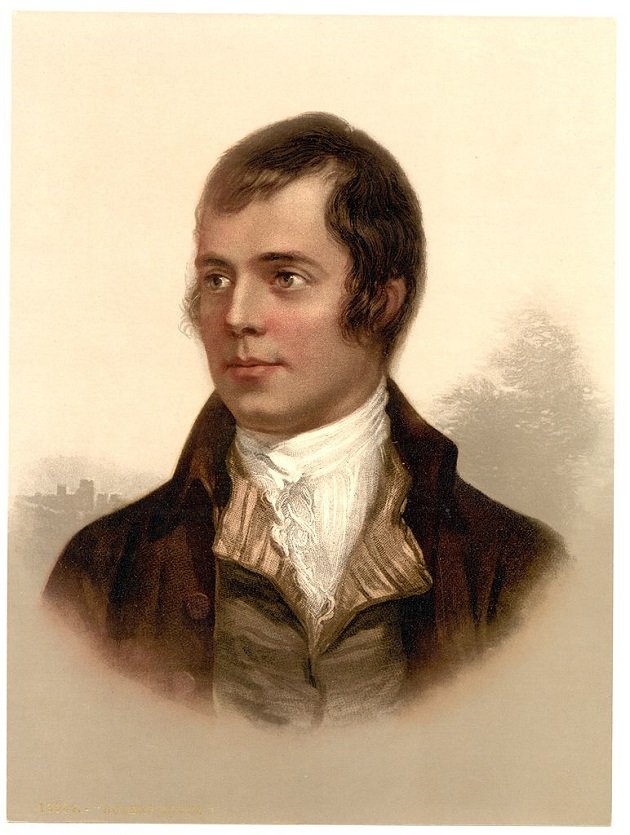
A portrait of “Rabbie Burns”, also known as “the Ploughman Poet” and “the Bard of Ayrshire”, among several other epithets.
Although Burns’s celebrated Address to the Haggis of 1787 – recited annually at every Burns Supper – makes no mention of whisky, even those who’ve never tasted this unlikely concoction of ovine offal know that haggis is traditionally washed down with copious amounts of the stuff. And a good thing, too: it’s always wise to have generous supply of whisky on hand anytime there’s sheep heart, lung, liver, and stomach on the dinner menu. An excellent whisky selection for any Burns Supper is the The Famous Grouse, which is not only the best-selling brand of whisky in Scotland but also features the best-known bird in the world of whisky.

Black Grouse by English artist Edward Lear (1812-1888).
As a brand name, “The Famous Grouse” makes for a rather boastful claim – particularly with that obligatory definite article. After all, it’s the famous grouse, leaving no room in this lek for any pretenders to the throne. And for over the first century of the label’s existence, this remained the case. The Famous Grouse brand was founded in 1896 in Perth and adopted its now-legendary grouse logo sometime in the early twentieth century, an image first drawn by Phillippa Gloag, the daughter of the company owner. Over time, the mascot has evolved from a silhouetted gamecock to the unmistakable painted likeness of not just any grouse, but an adult male “Red Grouse” (Lagopus lagopus scotica) sporting his flashy red eye-combs, standing tall and strutting his stuff on the majestic Scottish landscape, on guard against any hopeful rivals. He’s even been given a name: Gilbert.
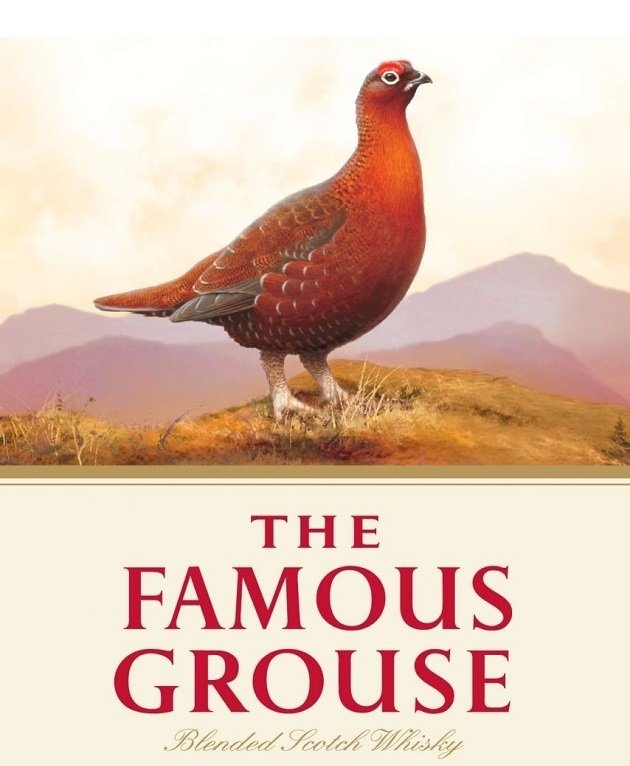
Gilbert: The Famous Grouse
Like all other “Red Grouse”, Gilbert is a member of a subspecies of Willow Ptarmigan found in the heather moorland of Great Britain and Ireland, a population that’s treated by some authorities as a separate species. It’s also one of Scotland’s most iconic birds and the favorite quarry of hunters during the August season that begins on “The Glorious Twelfth”. (The controversial management of Scotland’s grouse moors for these hunts is discussed in last week’s edition of Birds and Booze.)
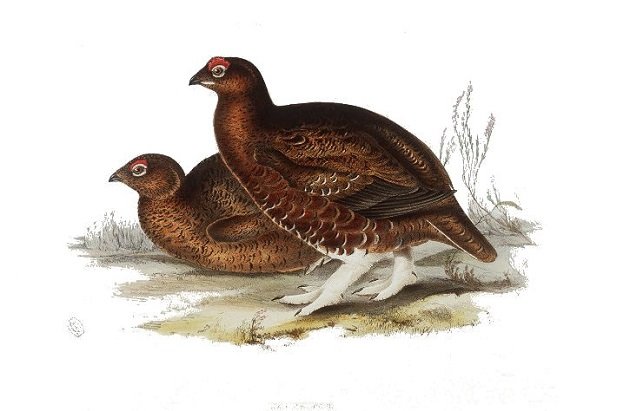
Red Grouse by English ornithologist and artist John Gould (1804-1881), from The Birds of Europe. The “Red Grouse” is considered by some authorities to be a subspecies of the Willow Ptarmigan, a bird whose common name comes from the Scots Gaelic tàrmachan, meaning “croaker”. The silent “p” was added to “ptarmigan” in 1684 by the Scottish antiquarian Sir Robert Sibbald, to give it an air of ancient Greek.
Gilbert the “Red Grouse” enjoyed a good and long reign as the lone, undisputed claimant of The Famous Grouse title. But no longer. “Grouse” serves as both the singular and plural and this quirk of English grammar has granted The Famous Grouse the leeway in recent years to add more grouse to its former lineup of one, without the trouble of changing the original brand name – a rather tidy, little loophole. These days, there’s now no longer just one famous grouse, but a small covey of famous grouse. Joining Gilbert in The Famous Grouse lek – sorry, old boy! – are two new birds on the block: The Snow Grouse (a blended grain whisky featuring the snowy white Willow Ptarmigan) and today’s featured whisky, The Famous Grouse Smoky Black.

Originally released in 2007 as The Black Grouse, the Smoky Black version is a peated whisky that introduces an altogether new species to The Famous Grouse roster, the Black Grouse. There’s no question that the original “Red Grouse” will remain the more famous grouse, but the Black Grouse makes a worthy addition to The Famous Grouse clan nonetheless. And with his striking jet-black plumage, he’s the perfect fowl to represent this darker, smoky offering from The Famous Grouse.
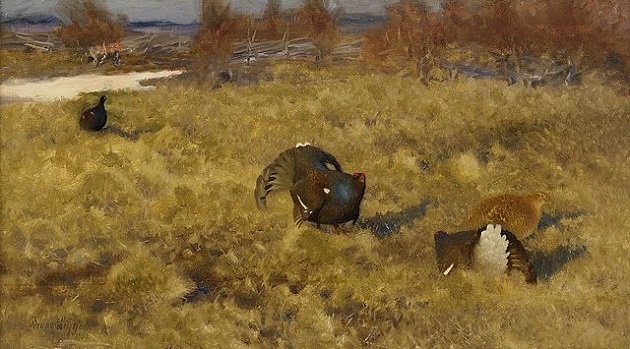
Black Grouse Displaying (1907) by Swedish artist Bruno Liljefors (1860-1939).
Smoky Black retains the trademark sweetness of The Famous Grouse brand, thanks to contributions to the blend from single malt distilleries The Macallan and Highland Park (the latter being the northernmost Scotch distillery in the world, way up in the Orkney Islands). To these is added a tasteful dash of peated whisky from Islay, spirits distilled from malted barley that’s been smoked over fires of peat, the dark and dense buildup of rotting moss that’s been burned as a fuel across northern Europe since the Stone Age. The result is a blended whisky with a mild aroma of peak smoke – though not nearly as pungent and briny as the most assertive examples from Islay – with a pleasing malt sweetness that recalls candy apple and rum raisin, accented by hints of anise and sherry cask oak. There’s more subtle smoke on the palate, along with hints of vanilla, smooth and rich toffee and cocoa, and a spicy, drying flash of salted licorice in the finish.
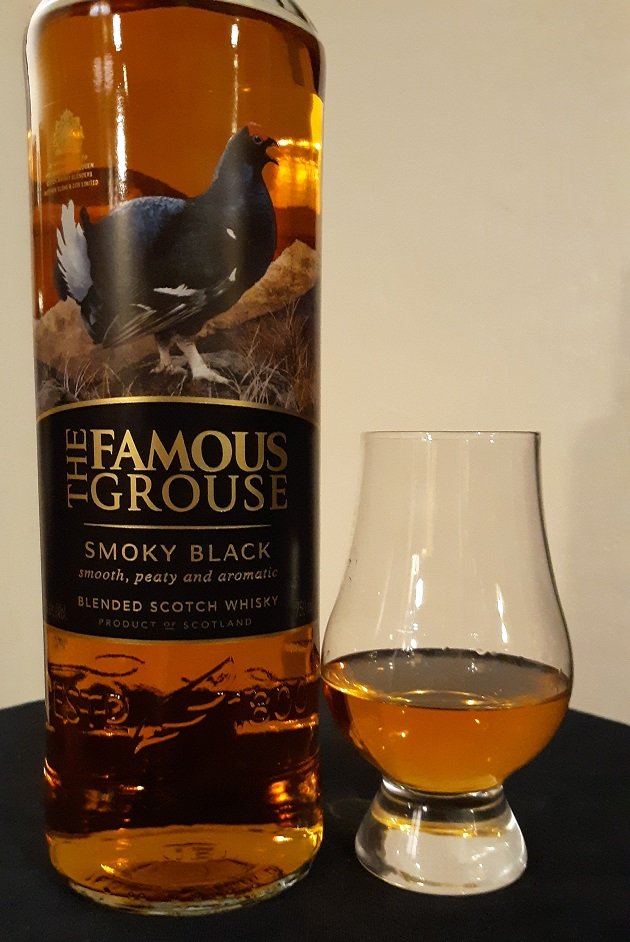
Not only is The Famous Grouse Smoky Black a delicious blended whisky with a handsome bird on the label, but enjoying it supports a good cause. Since 2008, the brand has been in partnership with the Royal Society for the Protection of Birds to support Black Grouse conservation efforts, with a portion of sales from every bottle of Smoky Black sold going directly to the Society. In 2018, The Famous Grouse redesigned the Smoky Black label to celebrate the tenth anniversary of this affiliation, by which point it had raised over £650,000 (around $840,000) for the Society, which has helped increased the Black Grouse population on four RSPB reserves by thirty percent in a decade (for more on the partnership between The Famous Grouse and the RSPB, visit the RSBP site).
***
Where the grouse lead their coveys thro’ the heather to feed,
And the shepherd tends his flock as he pipes on his reed.
From “Yon Wild Mossy Mountains” (1786) by Robert Burns.
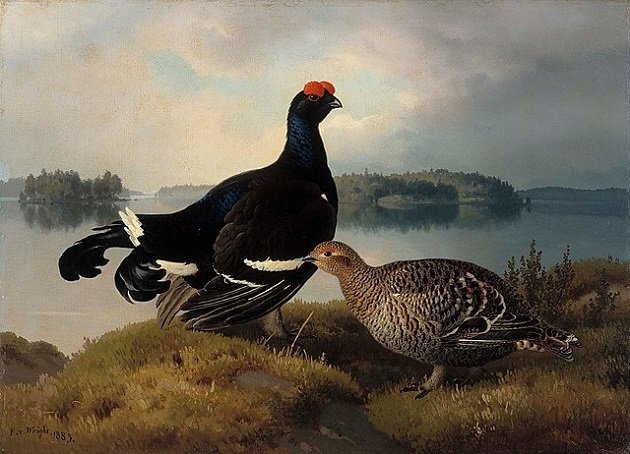
Black Grouse, Cock and Hen by Ferdinand von Wright.
Slànte mhath! Good birding and happy drinking!
The Famous Grouse: Smoky Black Blended Scotch Whisky
![]()
![]()
![]()
![]()
![]()
Three out of five feathers (Good).











Leave a Comment